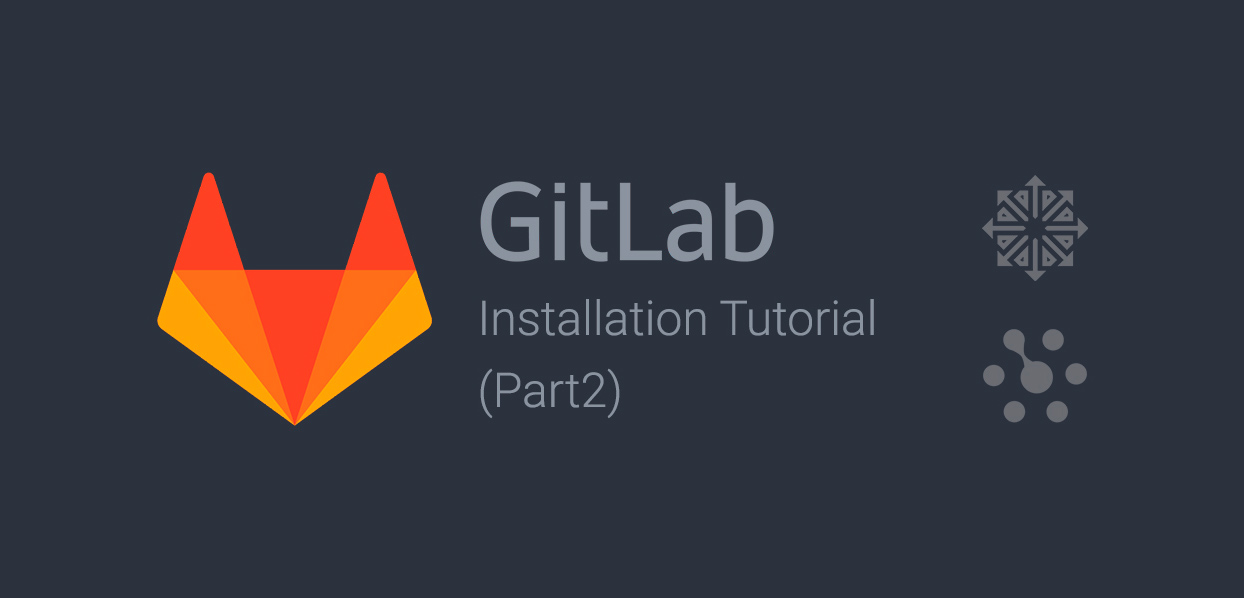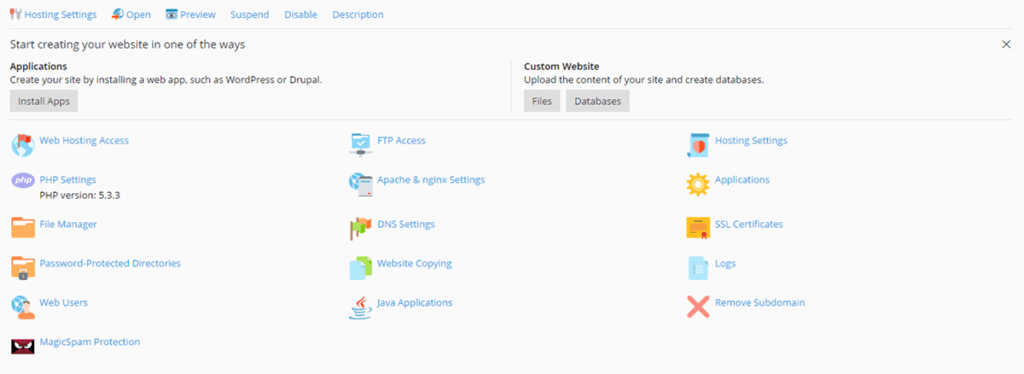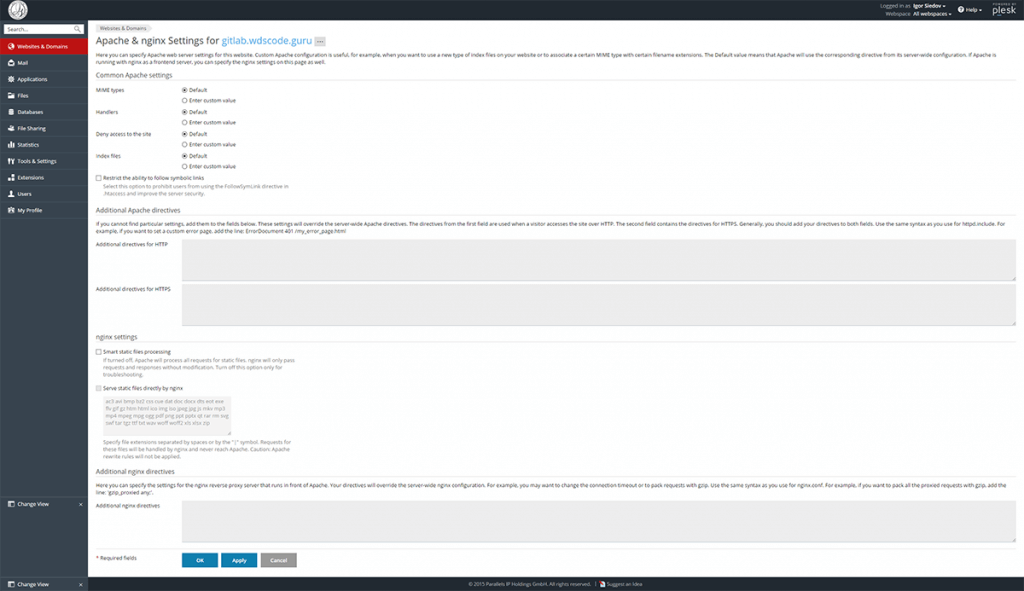Step 3 – Plesk Integration
After GitLab is successfully configured, there is Plesk integration next.
Create /etc/nginx/conf.d/gitlab.conf file with the following content
For GitLab version 7:
upstream gitlab {
server unix:/var/opt/gitlab/gitlab-rails/sockets/gitlab.socket fail_timeout=0;For GitLab 8.0.x/8.1.x , that performs gitlab-git-http-server:
upstream gitlab {
server unix:/var/opt/gitlab/gitlab-rails/sockets/gitlab.socket fail_timeout=0;For GitLab 8.2.x, that present gitlab-workhorse:
upstream gitlab {
server unix:/var/opt/gitlab/gitlab-rails/sockets/gitlab.socket fail_timeout=0;When there are a lot of data, it may occur 413 error, so to avoid it just be sure that the http section of /etc/sw-cp-server/config file have the following line:
client_max_body_size 2048m;Reload nginx with:
/etc/init.d/nginx reloador restart the service with:
service nginx restartAt this point create a new domain or subdomain (like gitlab.wdscode.guru) in Plesk, and in its configuration click on “Apache & nginx Settings” (“Web server settings” on Plesk 12.0) for the chosen domain.
Uncheck all the options in the “nginx settings” section and add the following text in the “Additional nginx directives” text area for GitLab 7:
location /uploads/ {
## If you use HTTPS make sure you disable gzip compression
## to be safe against BREACH attack.
# gzip off; proxy_read_timeout 300;
proxy_connect_timeout 300;
proxy_redirect off;
proxy_set_header Host $http_host;
proxy_set_header X-Real-IP $remote_addr;
proxy_set_header X-Forwarded-Ssl on;
proxy_set_header X-Forwarded-For $proxy_add_x_forwarded_for;
proxy_set_header X-Forwarded-Proto $scheme;
proxy_set_header X-Frame-Options SAMEORIGIN;
proxy_pass http://localhost:8080;
}
location @gitlab {
## If you use HTTPS make sure you disable gzip compression
## to be safe against BREACH attack.
# gzip off;
proxy_read_timeout 300;
proxy_connect_timeout 300;
proxy_redirect off;
proxy_set_header Host $http_host;
proxy_set_header X-Real-IP $remote_addr;
proxy_set_header X-Forwarded-Ssl on;
proxy_set_header X-Forwarded-For $proxy_add_x_forwarded_for;
proxy_set_header X-Forwarded-Proto $scheme;
proxy_set_header X-Frame-Options SAMEORIGIN;
proxy_pass http://localhost:8080;
}
location ~ ^/(assets)/ {
root /opt/gitlab/embedded/service/gitlab-rails/public;
gzip_static on;
# to serve pre-gzipped version expires max;
add_header Cache-Control public;
}
location ~ / {
root /opt/gitlab/embedded/service/gitlab-rails/public;
try_files $uri $uri/index.html $uri.html @gitlab;
}
error_page 502 /502.html;for GitLab 8.0.x/8.1.x (with gitlab-git-http-server):
location /uploads/ {
## If you use HTTPS make sure you disable gzip compression
## to be safe against BREACH attack.
# gzip off; proxy_read_timeout 300;
proxy_connect_timeout 300;
proxy_redirect off;
proxy_set_header Host $http_host;
proxy_set_header X-Real-IP $remote_addr;
proxy_set_header X-Forwarded-Ssl on;
proxy_set_header X-Forwarded-For $proxy_add_x_forwarded_for;
proxy_set_header X-Forwarded-Proto $scheme;
proxy_set_header X-Frame-Options SAMEORIGIN;
proxy_pass http://localhost:8080;
}
location @gitlab {
## If you use HTTPS make sure you disable gzip compression
## to be safe against BREACH attack.
# gzip off;
proxy_read_timeout 300;
proxy_connect_timeout 300;
proxy_redirect off;
proxy_set_header Host $http_host;
proxy_set_header X-Real-IP $remote_addr;
proxy_set_header X-Forwarded-Ssl on;
proxy_set_header X-Forwarded-For $proxy_add_x_forwarded_for;
proxy_set_header X-Forwarded-Proto $scheme;
proxy_set_header X-Frame-Options SAMEORIGIN;
proxy_pass http://localhost:8080;
}
location ~ ^/[\w\.-]+/[\w\.-]+/(info/refs|git-upload-pack|git-receive-pack)$ {
error_page 418 = @gitlab-git-http-server;
return 418;
}
location ~ ^/[\w\.-]+/[\w\.-]+/repository/archive {
error_page 418 = @gitlab-git-http-server;
return 418;
}
location ~ ^/api/v3/projects/.*/repository/archive { error_page 418 = @gitlab-git-http-server;
return 418;
}
location @gitlab-git-http-server {
## If you use HTTPS make sure you disable gzip compression
## to be safe against BREACH attack.
# gzip off;
proxy_read_timeout 300;
proxy_connect_timeout 300;
proxy_redirect off;
proxy_buffering off;
# The following settings only work with NGINX 1.7.11 or newer
# # # Pass chunked request bodies to gitlab-git-http-server as-is
# proxy_request_buffering off;
# proxy_http_version 1.1;
proxy_set_header Host $http_host; proxy_set_header X-Real-IP $remote_addr;
proxy_set_header X-Forwarded-Ssl on;
proxy_set_header X-Forwarded-For $proxy_add_x_forwarded_for;
proxy_set_header X-Forwarded-Proto $scheme;
proxy_pass http://gitlab-git-http-server; } location ~ ^/(assets)/ { root
/opt/gitlab/embedded/service/gitlab-rails/public;
gzip_static on;
expires max;
add_header Cache-Control public;
}
location ~ / { root /opt/gitlab/embedded/service/gitlab-rails/public;
try_files $uri $uri/index.html $uri.html @gitlab;
}
error_page 502 /502.html;for GitLab 8.2.x (with gitlab-workhorse):
location /uploads/ {
## If you use HTTPS make sure you disable gzip compression
## to be safe against BREACH attack.
# gzip off;
proxy_read_timeout 300;
proxy_connect_timeout 300;
proxy_redirect off;
proxy_set_header Host $http_host;
proxy_set_header X-Real-IP $remote_addr;
proxy_set_header X-Forwarded-For $proxy_add_x_forwarded_for;
proxy_set_header X-Forwarded-Proto $scheme;
proxy_set_header X-Frame-Options SAMEORIGIN;
proxy_pass http://localhost:8080;
}
location @gitlab {
## If you use HTTPS make sure you disable gzip compression
## to be safe against BREACH attack.
# gzip off;
proxy_read_timeout 300;
proxy_connect_timeout 300;
proxy_redirect off;
proxy_set_header Host $http_host;
proxy_set_header X-Real-IP $remote_addr;
proxy_set_header X-Forwarded-For $proxy_add_x_forwarded_for;
proxy_set_header X-Forwarded-Proto $scheme;
proxy_set_header X-Frame-Options SAMEORIGIN;
proxy_pass http://localhost:8080;
} location ~ ^/[\w\.-]+/[\w\.-]+/gitlab-lfs/objects {
client_max_body_size 0;
error_page 418 = @gitlab-workhorse;
return 418;
}
location ~ ^/[\w\.-]+/[\w\.-]+/(info/refs|git-upload-pack|git-receive-pack)$ {
client_max_body_size 0;
error_page 418 = @gitlab-workhorse;
return 418;
}
location ~ ^/[\w\.-]+/[\w\.-]+/repository/archive {
client_max_body_size 0;
error_page 418 = @gitlab-workhorse;
return 418;
} location ~ ^/api/v3/projects/.*/repository/archive {
client_max_body_size 0;
error_page 418 = @gitlab-workhorse;
return 418;
}
location ~ ^/[\w\.-]+/[\w\.-]+/builds/download {
client_max_body_size 0;
error_page 418 = @gitlab-workhorse;
return 418;
}
location ~ /ci/api/v1/builds/[0-9]+/artifacts {
client_max_body_size 0;
error_page 418 = @gitlab-workhorse;
return 418;
}
Get a Custom Solution with Web Design Sun
At Web Design Sun, we specialize in building web applications for clients in every business and industry. If you’re interested in custom applications for your business, contact us today.
Contact us today to get started



